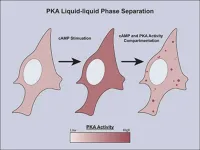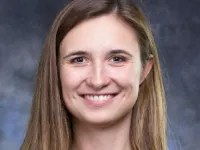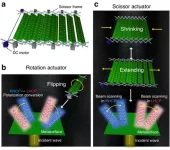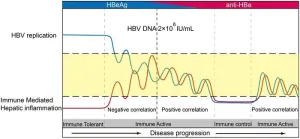(Press-News.org) As the World Health Organization (WHO) pushes for countries to seal the Pandemic Treaty by May this year, researchers at the University of Warwick and Kings College London stress the need for fair negotiations.
The opinion piece, featured in PLOS Global Public Health journal, is led by Professor Sharifah Sekalala . The team highlights the importance of considering "Time Equity" in these talks, urging caution on setting deadlines and sharing the burden when time is tight.
Since COVID-19 hit, demands for health equity have echoed worldwide, sparking discussions on fair frameworks to tackle future crises. Negotiating the Pandemic Treaty stands out as a crucial step, aiming for fair vaccine distribution, accessible healthcare, and stronger health systems.
Unlike past agreements, urgency for the Pandemic Treaty has surged, with the WHO Director-General calling for swift action. But rushing poses risks, especially in fairly dividing time and resources among all involved. Low- and middle-income countries (LMICs) risk being sidelined, forced into a speedy process without their say.
Professor Sekalala warns against haste, noting LMICs' challenges in such negotiations. Balancing speed with inclusivity is vital to protect everyone's interests.
Professor Sekalala said: "LMICs face inherent challenges in multilateral treaty negotiations, stemming from resource inequities and knowledge asymmetries,"
"Balancing the need for expediency with inclusivity and transparency is crucial to safeguard the interests of all parties involved."
As talks heat up, researchers suggest a fairer approach, viewing the May 2024 deadline as a chance for dialogue, especially for LMICs with limited representation.
Sekalala stresses on outcomes that benefit LMICs, like time-limited waivers on intellectual property and sustainable health financing. Prioritising these will make the Pandemic Treaty a tool for global health fairness.
ENDS
For more information, or to arrange interviews, please contact:
Bron Mills
Communications Officer
bron.mills@warwick.ac.uk | +447824 540 720
Full report available for viewing here: https://journals.plos.org/globalpublichealth/article?id=10.1371/journal.pgph.0003118
END
International Lawyer from the University of Warwick calls for fairness in WHO Pandemic Treaty Talks
As the World Health Organization (WHO) pushes for countries to seal the Pandemic Treaty by May this year, researchers at the University of Warwick and Kings College London stress the need for fair negotiations
2024-04-22
ELSE PRESS RELEASES FROM THIS DATE:
International Society for Autism Research (INSAR) 23rd Annual Meeting to be held in Melbourne, Australia May 15-18, 2024
2024-04-22
The International Society for Autism Research (INSAR) will hold its 2024 Annual Meeting – the organization’s 23rd – from Wednesday, May 15 through Saturday, May 18, 2024, bringing together a global, multidisciplinary group of more than 1,200 autism researchers, clinicians, advocates, self-advocates, and students from 20 countries to exchange the latest scientific learnings and discoveries that are advancing the expanding understanding of autism and its complexities. This year’s ...
Liquid droplets shape how cells respond to change
2024-04-22
Healthy cells respond appropriately to changes in their environment. They do this by sensing what’s happening outside and relaying a command to the precise biomolecule in the precise domain that can carry out the necessary response. When the message gets to the right domain at the right time, your body stays healthy. When it ends up at the wrong place at the wrong time, you can get diseases such as diabetes or cancer.
The routes that messages take inside a cell are called signaling pathways. Cells use only a few signaling pathways to respond simultaneously to hundreds of external signals, so those pathways need to be tightly ...
COS Mason researchers translating research into practice to create climate-ready communities across Virginia
2024-04-22
COS Mason Researchers Translating Research Into Practice To Create Climate-Ready Communities Across Virginia
Four Mason researchers received funding for: “ART: Translating Research into Practice to Create Climate-Ready Communities Across Virginia.”
Leah Nichols, Executive Director, Institute for a Sustainable Earth, Research and Innovation Initiatives; James Kinter, Professor, Climate Dynamics, Atmospheric, Oceanic and Earth Sciences (AOES); Director, Center for Ocean-Land-Atmosphere Studies (COLA); Luis Ortiz, Assistant Professor, AOES; and Celso Ferreira, Associate Professor, Sid and Reva Dewberry Department of Civil, Environmental, and Infrastructure Engineering, are ...
Hao receives funding for NOAA AMSU-A CDR Products Support
2024-04-22
Hao Receives Funding for NOAA AMSU-A CDR Products Support ...
Life goals and their changes drive success
2024-04-22
“Where is my life going?” “Who do I want to be?”
As future-thinkers, adolescents spend significant time contemplating these types of questions about their life goals. A new study from the University of Houston shows that as people grow from teenagers to young adults, they tend to change the importance they place on certain life goals, but one thing is certain: The existence of high prestige and education goals, as well as their positive development, can drive success.
“Adolescents who endorsed higher levels of prestige and education goals tended to have higher educational attainment, income, ...
Newmetasurface innovation unlocks precision control in wireless signals
2024-04-22
Researchers have unveiled a technology that propels the field of wireless communication forward. This cutting-edge design, termed a reconfigurable transmissive metasurface, utilizes a synergistic blend of scissor and rotation actuators to independently manage beam scanning and polarization conversion. This introduces an innovative approach to boosting signal strength and efficiency within wireless networks.
Reconfigurable metasurfaces are transforming wireless communication by adjusting electromagnetic (EM) wave characteristics such as amplitude, phase, and polarization. These planar arrays enhance wave control, boosting functionalities ...
The relationship between viral replication and the severity of hepatic necroinflammatory damage changed before HBeAg loss in patients with chronic hepatitis B virus infection
2024-04-22
Background and Aims
Disease progression of chronic hepatitis B virus (HBV) infection is driven by the interactions between viral replication and the host immune response against the infection. This study aimed to clarify the relationship between HBV replication and hepatic inflammation during disease progression.
Methods
Two cross-sectional, one validation cohort, and meta-analyses were used to explore the relationship between HBV replication and liver inflammation. Spearman analysis, multiple linear regression, and logistic regression were used to explore the relationship between variables.
Results
In ...
Sleeter to receive funding for website project
2024-04-22
Nathan Sleeter, Research Assistant Professor, History and Art History, Roy Rosenzweig Center for History and New Media (RRCHNM), is set to receive funding for: “American Indian Science and Engineering Society (AISES) at 50 website.”
RRCHNM researchers will develop a website that will tell the story of AISES’s first 50 years, its founding mission, its growth, and the individuals who have been part of its work supporting American Indians in STEM. Sleeter will serve as project director.
The researchers will also conduct and record oral history ...
Alem conducting PRNT analysis of samples from Athari Biosciences
2024-04-22
Farhang Alem, Interim Director of the Biomedical Research Laboratory, Institute for Biohealth Innovation, received funding for: “PRNT Analysis of Samples from Athari BioSciences.”
Researchers with the Biomedical Research Laboratory will perform Plaque Reduction Neutralization Tests (PRNTs) on Athari patient serum samples with parameters defined by Athari. They will also produce and deliver a report containing all patient serum sample titer results for SARS-CoV-2.
PRNT analysis is a serological test that utilizes the ability of a specific antibody to neutralize a virus, and in turn, prevent the virus ...
Mosaics of predisposition cause skin disease
2024-04-22
Clarifying the cause of a skin disease led to the discovery of a new disease-causing gene, a new category of diseases, and new perspectives for both counseling and therapy. The Kobe University discovery is the first time that epigenetic silencing, the “switching off” of an otherwise intact gene, has been recognized as the cause for a skin disease.
Porokeratosis is a skin disease that leads to the development of annular or circular, red and itchy lesions. In some individuals, these develop all over the body, in some localized in lines, and in some only in one or very few spots. Kobe University dermatologist KUBO Akiharu previously ...
LAST 30 PRESS RELEASES:
IADR elects George Belibasakis as vice-president
Expanding the search for quantum-ready 2D materials
White paper on leadership opportunities for AI to increase employee value released by University of Phoenix College of Doctoral Studies
ASH 2025: New combination approach aims to make CAR T more durable in lymphoma
‘Ready-made’ T-cell gene therapy tackles ‘incurable’ T-cell leukemia
How brain activity changes throughout the day
Australian scientists reveal new genetic risk for severe macular degeneration
GLP-1 receptor agonists likely have little or no effect on obesity-related cancer risk
Precision immunotherapy to improve sepsis outcomes
Insilico Medicine unveils winter edition of Pharma.AI, accelerating the path to pharmaceutical superintelligence
Study finds most people trust doctors more than AI but see its potential for cancer diagnosis
School reopening during COVID-19 pandemic associated with improvement in children’s mental health
Research alert: Old molecules show promise for fighting resistant strains of COVID-19 virus
Journal of Nuclear Medicine Technology supplement highlights advances in theranostics and opportunities for growth
New paper rocks earthquake science with a clever computational trick
ASH 2025: Milder chemo works for rare, aggressive lymphoma
Olfaction written in bones: New insights into the evolution of the sense of smell in mammals
Engineering simulations rewrite the timeline of the evolution of hearing in mammals
New research links health impacts related to 'forever chemicals' to billions in economic losses
Unified EEG imaging improves mapping for epilepsy surgery
$80 million in donations propels UCI MIND toward world-class center focused on dementia
Illinois research uncovers harvest and nutrient strategies to boost bioenergy profits
How did Bronze Age plague spread? A sheep might solve the mystery
Mental health professionals urged to do their own evaluations of AI-based tools
Insufficient sleep associated with decreased life expectancy
Intellicule receives NIH grant to develop biomolecular modeling software
Mount Sinai study finds childhood leukemia aggressiveness depends on timing of genetic mutation
RSS Research Award for new lidar technology for cloud research
Novel AI technique able to distinguish between progressive brain tumours and radiation necrosis, York University study finds
Why are abstinent smokers more sensitive to pain?
[Press-News.org] International Lawyer from the University of Warwick calls for fairness in WHO Pandemic Treaty TalksAs the World Health Organization (WHO) pushes for countries to seal the Pandemic Treaty by May this year, researchers at the University of Warwick and Kings College London stress the need for fair negotiations




